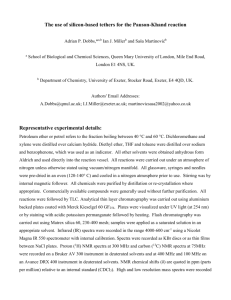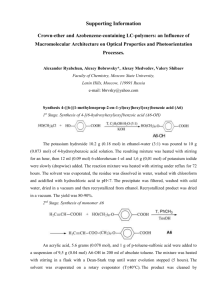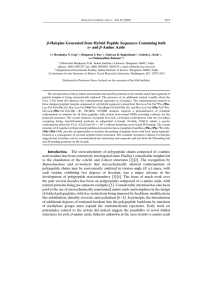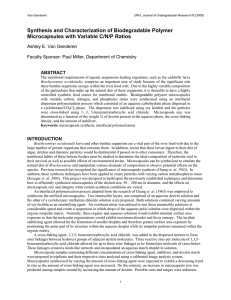Preparation of Base-amplifying Microcapsules
advertisement
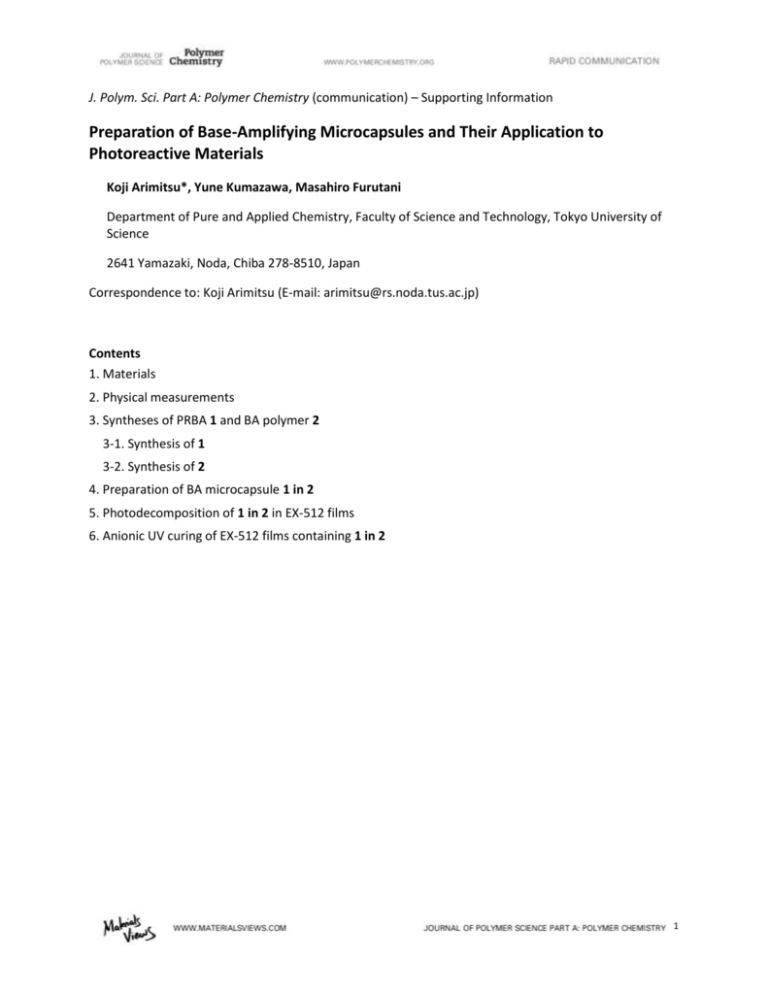
J. Polym. Sci. Part A: Polymer Chemistry (communication) – Supporting Information Preparation of Base-Amplifying Microcapsules and Their Application to Photoreactive Materials Koji Arimitsu*, Yune Kumazawa, Masahiro Furutani Department of Pure and Applied Chemistry, Faculty of Science and Technology, Tokyo University of Science 2641 Yamazaki, Noda, Chiba 278-8510, Japan Correspondence to: Koji Arimitsu (E-mail: arimitsu@rs.noda.tus.ac.jp) Contents 1. Materials 2. Physical measurements 3. Syntheses of PRBA 1 and BA polymer 2 3-1. Synthesis of 1 3-2. Synthesis of 2 4. Preparation of BA microcapsule 1 in 2 5. Photodecomposition of 1 in 2 in EX-512 films 6. Anionic UV curing of EX-512 films containing 1 in 2 1 1. MATERIALS The reagents used were purchased from Tokyo Chemical Industry Co., Ltd. (Tokyo, Japan) and Wako Pure Chemical Industries, Ltd. (Osaka, Japan). A water-soluble epoxy resin, EX-512, was supplied by Nagase ChemteX Corporation (Osaka, Japan). All chemicals were used without further purification. 2. PHYSICAL MEASUREMENTS 1 H-NMR spectra were obtained using a JEOL JNM-ECP500 spectrometer. Gel permeation chromatography (GPC) was performed using a Hitachi High-Tech. L-2130 pump and a Hitachi High-Tech. L-2490 RI detector with a Gelpack GL-A140-S column. FT-IR spectral measurements were performed using a JASCO FT/IR-6100 spectrometer. Emulsification was carried out using an SMT UH-600S homogenizer. SEM observation was carried out using a HITACHI S-3000N. SEM samples were coated with palladium–gold. Photoirradiation was carried out using either a San-ei Supercure-203S Hg–Xe lamp or a Funakoshi Compact UV Lamp UVG-11. The light from the Hg–Xe lamp was monochromated at 365 nm by passing it through a glass filter (UVD-36A, Asahi Glass Co., Ltd.). The pencil-hardness test was carried out using a Yasuda No. 533-M. 3. SYNTHESES OF PRBA 1 AND BA POLYMER 2 3-1. Synthesis of 1 SCHEME S1 Synthesis of 1. 3-1-1. Synthesis of 4,5-dimethoxy-2-nitro-phenyl-9H-fluoren-9-yl-methanol Potassium hydroxide (0.30 g) in methanol/THF (2/5, v/v, 14 mL) was added to fluorene (3.00 g, 1.8 mmol) in THF (20 mL), and the mixture was stirred at room temperature for 15 min. 6Nitroveratraldehyde (3.00 g, 1.4 mmol) in THF (20 mL) was added, and the mixture was stirred at 0 C for 3 h. After adding chloroform, the organic layer was washed three times with 7 wt% aqueous HCl solution, saturated aqueous NaHCO3 solution and brine, followed by drying over MgSO4. Purification of the residue was performed by column chromatography with ethyl acetate/hexane (1/2, v/v) to give 4,5dimethoxy-2-nitro-phenyl-9H-fluoren-9-yl-methanol in 25% yield (1.3 g) as a yellow solid. 1H-NMR (500 MHz, CDCl3): 1.77 (d, 1H, J = 4.0 Hz, –OH), 3.8–4.1 (m, 6H, –OCH3), 4.50 (d, 1H, J = 4.0 Hz, >CH–CH(OH)– ), 6.32 (t, 1H, J = 4.0 Hz, >CH–OH), 7.2–7.8 (m, 10H, Ar–H). 3-1-2. Synthesis of 1 Hexamethylene diisocyanate (0.36 g, 2.1 mmol) in anhydrous benzene (10 mL) was added to 4,5dimethoxy-2-nitro-phenyl-9H-fluoren-9-yl-methanol (1.80 g, 4.8 mmol) and dibutyltin dilaurate (0.04 g, 0.06 mmol) in anhydrous benzene (10 mL). The mixture was refluxed for 9 h. After adding chloroform, the organic layer was washed three times with 7 wt% aqueous HCl solution, saturated aqueous NaHCO3 solution and brine, followed by drying over MgSO4. Purification of the residue was performed by column chromatography with ethyl acetate/hexane (1/1, v/v) to give 1 in 20% yield (0.40 g) as a yellow solid. 1H- 2 NMR (500 MHz, CDCl3): 1.0–1.6 (m, 12H, –CH2–), 3.72 (s, 6H, –OCH3), 3.95 (s, 6H, –OCH3), 4.5–4.6 (m, 4H, >CH–CH(Ar)–O–, –NH–), 6.95 (d, 2H, J = 8.0 Hz, –CH(Ar)–O–), 7.2–7.7 (m, 20H, –CH2–). 3-2. Synthesis of 2 SCHEME S2 Synthesis of 2. 3-2-1. Synthesis of 3S1 9-Fluorenylmethanol (6.0 g, 31 mmol) and dibutyltin dilaurate (0.08 g, 0.12 mmol) in anhydrous benzene (30 mL) were slowly added to a solution of 2-isocyanatoethyl methacrylate (4.8 g, 31 mmol) in anhydrous benzene (30 mL). The mixture was refluxed for 3 h. After evaporation, the residue was purified by recrystallization from ethanol to give monomer 3 in 58% yield (6.2 g) as a white solid. 1H-NMR (500 MHz, CDCl3): 1.95 (s, 3H, –CH3), 3.52 (q, 2H, J = 5.0 Hz, –NH–CH2–CH2–), 4.2–4.3 (m, 1H, –O–CH2–CH<), 4.2– 4.3 (m, 2H, –O–CH2–CH2–), 4.41 (d, 2H, J = 7.0 Hz, –O–CH2–CH<), 5.04 (t, 1H, J = 5.0 Hz, –NH–), 5.60 (s, 1H, >C=CH2), 6.10 (s, 1H, >C=CH2), 7.3–7.8 (m, 8H, Ar–H). 3-2-2. Synthesis of 2S1 Monomer 3 (3.0 g, 8.5 mmol) and azobisisobutyronitrile (AIBN, 0.07 g, 0.4 mmol) in THF (30 mL) were refluxed for 10 h. Reprecipitation was performed with ether as a poor solvent to give 2 in 30% yield (0.9 g) as a white solid. 1H-NMR (500 MHz, CDCl3): 0.8–2.1 (m, 5H, methylene of main chain, –CH3), 3.0–4.5 (m, 7H, –COOCH2–CH2–, –COOCH2–CH<), 5.80 (br, 1H, NH), 7.1–7.8 (m, 8H, Ar–H). Mw = 1.3 104, Mw/Mn = 1.5. 4. PREPARATION OF BA MICROCAPSULE 1 IN 2 The dispersed phase (oil phase) consisted of 1 (0.01 g, 0.01 mmol), 2 (0.06 g, 0.22 mmol) and dichloromethane (5.0 g). The continuous phase (water phase) consisted of poly(vinyl pyrrolidone) (dispersion stabilizer, 0.5 g), sodium laurate (surfactant, 0.01 g) and water (30 g). The dispersed phase was poured into the continuous phase, and the mixture was homogenized at 5 C for 5 min using an ultrasonic homogenizer (constant = 50, output = 7) to form an O/W emulsion. The mixture was stirred at 35 C for 3 h under reduced pressure with an aspirator to remove dichloromethane. The resulting BA microcapsules were washed twice with distilled water. 3 Dichloromethane Water 1 Poly vinyl pyrrolidone 2 Sodium laurate The dispersed phase (Oil phase) The continuous phase (Water phase) O/W emulsion Liquid drying method Microcapsules FIGURE S1 Preparation of BA microcapsules using the liquid drying method. 5. PHOTODECOMPOSITION OF 1 IN 2 IN EX-512 FILMS An EX-512 film containing BA microcapsule 1 in 2 was prepared by drop-casting their aqueous solution (EX-512: 0.017 g, 1 in 2: 0.012 g and water: 0.75 g) on a silicon wafer, followed by drying in vacuo at room temperature (Figure S2). The content rate of 1 in 2 was 71 wt% (15 wt% of 1 and 56 wt% of 2, relative to EX-512). The film was exposed to 1000 mJ cm–2 of 365 nm light, and heated at 100 C for 0– 100 min before FT-IR spectral measurements. A control experiment was also performed with an EX-512 film containing 15 wt% of 1 and 56 wt% of 3. FT-IR spectral measurements Drop cast hn 1000 mJ cm-2 365 nm Postbake 100 oC 0-100 min FIGURE S2 Preparation and photodecomposition of 1 in 2 in EX-512 films. 6. ANIONIC UV CURING OF EX-512 FILMS CONTAINING 1 IN 2 An EX-512 film containing BA microcapsule 1 in 2 was prepared by bar-coating their aqueous solution (EX-512: 0.018 g, 1 in 2: 0.012 g and water: 0.23 g) on a glass plate, followed by prebaking at 80 C for 2 min (Figure S3). The content rate of 1 in 2 was 67 wt% (13 wt% of 1 and 54 wt% of 2, relative to EX-512). The film was exposed to 5000 mJ cm–2 of 365 nm light, and heated at 100 C for 0–90 min before pencil4 hardness tests. A control experiment was also performed with an EX-512 film containing 13 wt% of 1 and 54 wt% of 3. Pencil hardness test Glass Bar-coat Prebake 80oC, 2 min hn 365 nm 5000 mJ cm-2 Postbake 100oC 0-90 min FIGURE S3 Anionic UV curing of EX-512 films containing 1 in 2. Reference S1. A. Igarashi, K. Arimitsu, T. Seki, K. Ichimura, J. Mater. Chem. 2008, 18, 560. 5



